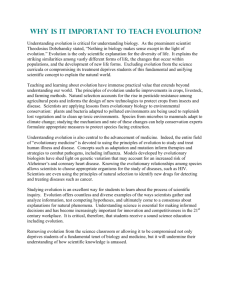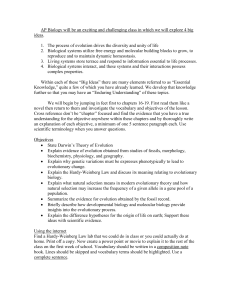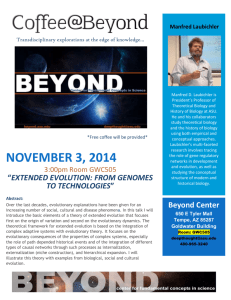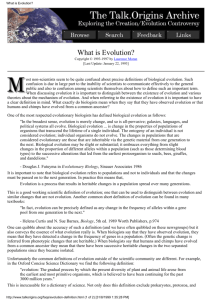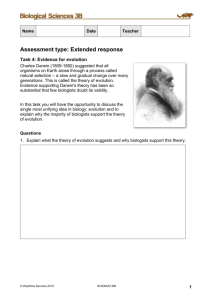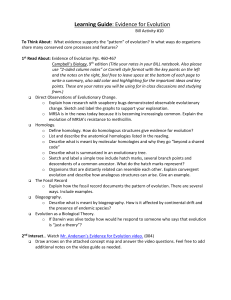Evolution for General Biology
advertisement
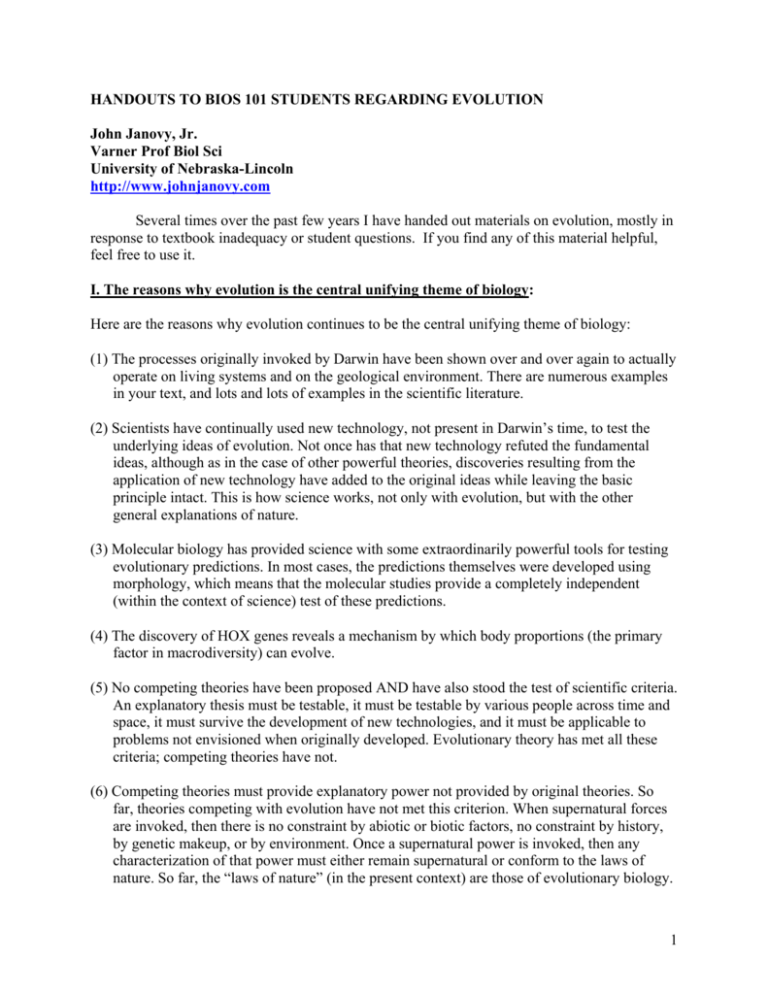
HANDOUTS TO BIOS 101 STUDENTS REGARDING EVOLUTION John Janovy, Jr. Varner Prof Biol Sci University of Nebraska-Lincoln http://www.johnjanovy.com Several times over the past few years I have handed out materials on evolution, mostly in response to textbook inadequacy or student questions. If you find any of this material helpful, feel free to use it. I. The reasons why evolution is the central unifying theme of biology: Here are the reasons why evolution continues to be the central unifying theme of biology: (1) The processes originally invoked by Darwin have been shown over and over again to actually operate on living systems and on the geological environment. There are numerous examples in your text, and lots and lots of examples in the scientific literature. (2) Scientists have continually used new technology, not present in Darwin’s time, to test the underlying ideas of evolution. Not once has that new technology refuted the fundamental ideas, although as in the case of other powerful theories, discoveries resulting from the application of new technology have added to the original ideas while leaving the basic principle intact. This is how science works, not only with evolution, but with the other general explanations of nature. (3) Molecular biology has provided science with some extraordinarily powerful tools for testing evolutionary predictions. In most cases, the predictions themselves were developed using morphology, which means that the molecular studies provide a completely independent (within the context of science) test of these predictions. (4) The discovery of HOX genes reveals a mechanism by which body proportions (the primary factor in macrodiversity) can evolve. (5) No competing theories have been proposed AND have also stood the test of scientific criteria. An explanatory thesis must be testable, it must be testable by various people across time and space, it must survive the development of new technologies, and it must be applicable to problems not envisioned when originally developed. Evolutionary theory has met all these criteria; competing theories have not. (6) Competing theories must provide explanatory power not provided by original theories. So far, theories competing with evolution have not met this criterion. When supernatural forces are invoked, then there is no constraint by abiotic or biotic factors, no constraint by history, by genetic makeup, or by environment. Once a supernatural power is invoked, then any characterization of that power must either remain supernatural or conform to the laws of nature. So far, the “laws of nature” (in the present context) are those of evolutionary biology. 1 One intellectual problem in invoking a supernatural power is that unless you allow that power to behave exactly as it wishes, even capriciously, then you have superimposed human characters on it. A second intellectual problem is that if a process that cannot be studied is assumed to be causal, then that process can cause anything. Thus “God did it” explains everything, but in the realm of science that is the same as explaining nothing. (7) From a purely political perspective, invoking a supernatural process for one natural phenomenon (biological diversity or the existence of humans) but not others (a long long list of phenomena) produces an inconsistency in thinking that immediately invalidates the Hand of God as a valid scientific explanation. Thus to be consistent with Intelligent Design theory, “God did it” or “God does it” should be an adequate explanation for the existence of the moon, gravity, electricity, black holes, nuclear disintegrations, plate tectonics, hurricanes, volcanoes, homosexuality, chemical reactions, . . . . etc. The disdain that most scientists have for ID or creationism stems largely from this highly selective use of the Hand of God in the culture wars. Such use seems to reveal ID and its related ideas clearly as religious politics, an activity as old and as vicious as any in recorded history, and not as science. (8) There is a substantial literature on the various realms of reality. Most of this literature is readily accessible to college students. The discipline of history, for example, uses data, evidence, and intellectual tools that are not necessarily applicable in the discipline of art. In the realm of science, data, evidence, and intellectual constraints are quite different from those in the realm of literature. Thus the realm of religion has criteria and constraints that simply do not apply in the sciences, and vice versa. Nobody is objecting to the use of all kinds of myths, including creation myths, as means by which individuals can organize their worlds, establish their behavioral options, find comfort in times of stress, or find personal answers to the question: Why am I here and cognizant of my surroundings? Plenty of people, however, object to using those same myths to justify political actions, guide foreign policy, and conduct affairs of the state. History shows clearly that religion as government policy is dangerous to people in general, no matter how powerful it may be as a source of individual strength. --JJ 2 II: A primer: EVOLUTION – A PRIMER, OR, HOW BIOLOGISTS VIEW THE SUBJECT: (1) All organisms—viruses to humans—are considered by the vast majority of scientists to evolve, and are considered to have evolved since life began. (2) Scientists do not know exactly how life originated, but there is quite a bit of biochemical and biophysical evidence that de novo origin of life is not impossible, and is not such a farfetched idea after all. (3) Certain of the Darwinian observations and ideas are commonly accepted as fact (inheritable variation, superfecundity, and differential survival). (4) The general picture of Earth’s history, as revealed by the geologists, geophysicists, and nuclear physicists, is considered accurate (factual), including time, continental drift, and geological processes. (5) All of the processes that affect both physical environment and organisms today are considered to have affected both the physical and living world since the origin of the planet (erosion, plate tectonics, volcanism, orogeny, inheritable variation, superfecundity, differential survival, etc.). (6) Science does not deny the existence of a supernatural power (God); science, does, however, deny that such a power can be studied from a scientific perspective, thus cannot be legitimately invoked as an explanation for natural phenomena. Creationism and Intelligent Design give rise to no testable hypotheses or predictions about the universe. (7) Science is not religion. Everything scientists discover and/or claim is up on the table for investigation and, if evidence warrants, refutation. Nothing is necessarily fixed in science, although structure, function, processes, and relationships revealed by research are considered facts until they are refuted by legitimate scientific means. Science itself does not address issues of morality although science can legitimately claim that behavior—including that of humans—is a valid area for scientific investigation by use of testable predictions. (8) To scientists, theories are powerful general explanations developed from diverse sources of evidence gathered using a variety of technologies. Scientists are, however, constantly putting theories to the test, especially when new technologies arise. For this reason, any general explanation that survives testing can become accepted as a theory. Thus the phrase “It’s just a theory” carries no weight with scientists. (9) Today, phylogenies (evolutionary histories) are all considered hypotheses to be tested. There are a number of powerful techniques for testing phylogenetic hypotheses. 3 (10) Evolution remains the central unifying theme of biological sciences because diverse kinds of research, most involving technologies not present in Darwin’s time and all focused on testing the general explanation, have failed to discredit the general ideas. (11) We now know enough about genetics to explain the origin of higher taxa fairly easily. (12) We now know that there are several kinds of genetic information (structural, regulatory, etc.) and that mutations can occur in any portion of the genome of any organism. (13) Real biologists never argue over the fact of evolution; they argue constantly, however, over the form and details of evolution. (14) Virtually all agricultural research up to the origin of molecular biology in the middle 1970s (i.e., several thousand years’ worth) was based on evolutionary principles. (15) We now know that the movement of infectious agents often can be explained on the basis of evolutionary principles. (16) We now know that phenomena such as drug resistance in infectious agents and insecticide resistance in insects of agricultural importance can be explained on the basis of evolutionary principles. (17) One truly major post-Darwinian addition to evolutionary theory is the evidence that eukaryotic cells arose by way of symbiosis. Thus, for example, mitochondria and chloroplasts are now considered symbionts that have become assembled into the structure and function of eukaryotic cells. (18) A second truly major post-Darwinian addition to evolutionary theory is the evidence, from molecular biology, that genes can and do have distinct evolutionary trajectories that may or may not match those of their owners. (19) The molecular biologists also have shown us that life on Earth is far more diverse, especially at the microbial levels, than we ever imagined. (20) Most scientists are truly mystified as to why the United States seems to be so consumed with the obviously political “creation vs. evolution” controversy, which is a controversy only because some members of some organized religions persist in making it so through use of religion as a weapon in the political wars, and not because there is any real evidence for either supernatural creation or intelligent design. 4 III. Chance and constraint in biological systems: Chance and constraint in biological systems One of the comments heard (or read) frequently in culture-wars discussions of evolution is “it’s too complex; it could not arise just by chance or by accident”—or something to that effect—“it” being any number of biological phenomena. Eyes, for example, often are considered so wonderfully complex and perfectly designed that they could not have arisen just “by chance.” Thus it seems appropriate in a non-majors science course to provide some information on what “by chance” actually means in biology. In general, one needs to remember that some events occur randomly, mutation being one of them, but these events also occur within biological systems as we know them. Such systems exert powerful constraints on events that occur randomly, and it’s these constraints, or boundary conditions, that seem to direct evolutionary change. Evolutionarily significant biological events that occur randomly (with your Campbell et al. text page number references) include such things as mutations (p. 199), independent assortment and distribution of alleles to gametes (p. 141), crossing over (p. 142, but constrained by position on chromosomes), and chromosomal mutations (p. 148). These events are major contributors to genetic diversity, a pre-condition for evolution. Evolutionarily significant events that usually do not occur randomly include, for example, mate selection (p. 275) and physiological responses to environmental conditions (see sections on immunity, digestion, behavior, etc.). Responses to environmental conditions are clearly and strongly influenced by genotype and phenotype, the latter in turn strongly influenced by developmental conditions (e.g. in utero effects on human embryos or diet of insect larvae). In other words, genotype and resulting phenotype exert constraints on change, which thus occurs only within the context of a pre-existing condition. Eyes, for example, don’t arise anew, fully-formed, “by chance;” they arise from previously existing eyes or light-sensitive structures, although extensive study of invertebrate animals is usually required before a person can understand why eyes, in all their various forms, can probably be considered one of the easiest structures for animals to acquire through evolution. “Random” means without a predictable pattern, although prediction in this case refers to the pattern, not to the occurrence itself. Thus we can predict that a mutation will occur, but we cannot predict exactly when a mutation will occur or in which genes. With enough study, however, we can estimate the probabilities that certain events will happen. Thus we know mutation rates for many alleles, failure rates for machinery, automobile accident rates, etc. From such rates, we can construct frequency distributions that predict the number of such events per unit time. With research, we can also determine underlying mechanisms for randomly occurring events, as in the case of radioactive isotope decay or mutation (e.g., nucleotide substitution or deletion). Mutation may occur at random, as in the appearance of a gene for fruit fly vestigial wings, but subsequent mate selection based on mating “songs” produced by vibrations of vestigial wings vs. normal wings, for example, is certainly not random. Thus the most powerful constraint of all on evolutionary change, i.e., the boundary conditions for change, is existing 5 genotype and the resulting phenotype. From viruses and bacteria, to protists such as Paramecium, to song birds, snakes, and people, change occurs only from an existing genotype and phenotype, and occurs only within the limits allowed by that genotype and phenotype. Stated simply, according to evolutionary principles, cats don’t evolve into dogs by chance, and birds don’t evolve into people, either. Instead, cats evolve into different kinds of cats and birds evolve into other kinds of birds. But as long as we’re talking about birds, remember that biologists now consider birds to be small dinosaurs (and for good reason). And there is plenty of evidence, both fossil and molecular, for a shared ancestry between cats and dogs. In order for us to understand evolutionary biology, however, it is important to remember exactly what it is that occurs randomly, and then to put such random occurrence into the context of boundary conditions and constraints. Complexity seen in living systems today seems at times to defy description, thus seems quite unlikely to have “arisen simply by chance.” Of particular interest in this context is complexity that seems to have some organization, some highly contrived, intricate, and interconnected functions that “seem just right” for whatever ecological situation they inhabit. --JJ 6 IV. A letter: October 20, 1999 TO: BioSci 101 Students, MWF 10:30, I-99-00 FROM: John Janovy, Jr. RE: Evolution As a result of our discussion on Friday, October 15, I’ve decided to pass along some thoughts on the subject of evolution, especially the teaching of it. This note is not an attempt to convince anyone that “evolution is a fact,” or to discredit anyone’s religious beliefs, but rather a reflection on what it means to enroll in a public university’s course in biological sciences. First, I’m not sure that I answered the student question “Do all biologists believe in evolution?” correctly. I probably should have said “No, probably not, but ‘believe’ may not be the right word in this case.” Had the question been “Do all biologists accept evolution as the best general explanation of all available information on biological diversity?” the answer would have been “Probably not, but certainly the vast and overwhelming majority of them do.” What is signified by the existence of professional biologists who don’t accept evolution as the best general explanation for biological diversity? In my opinion, not much. Biology is such a broad field that one can be a professional biologist and never personally address questions of evolution, or diversity, regardless of the fact [and it is a fact] that evolution is the central unifying theme of our discipline. [There have been times in history when this was not the case, e.g. from the Roman Empire until the 1850s.] Similarly, one can be a very successful attorney and never think twice about constitutional issues such as first amendment rights, one can be a very successful physician and never spend a second pondering the political and economic consequences of childhood diarrhea in developing nations, and one can be a very successful businessperson without ever taking a philosophical stand on various economic theories, or even knowing what those theories are. Secondly, as I have said before, at a public university there is nothing to be gained, intellectually, by avoiding the central unifying theme of a discipline, whether that discipline be physics, mathematics, philosophy, history, economics, or biology. Indeed, it is the responsibility of faculty members to make sure those central unifying themes, the “big pictures,” are presented and that much of the so-called factual material is placed within a context characterized by those central unifying themes. A faculty member is not responsible for convincing you that any of those themes are “true,” nor is that our goal. However, we are responsible for trying to help you understand the thought processes that characterize the discipline, and for asking that you be familiar with the raw information at our disposal. For example, the concept of a metabolic pathway is one of our thought processes; we use this concept all the time. Our knowledge of protein and DNA structure is an example of raw information at our disposal; we constantly use such factual information in our research and interpretation of new discoveries. As for evolution, it is not my fault that evolution is the central unifying theme of biology. I did not write Origin of Species, I did not discover the processes of plate tectonics, I did not provide science with the fossil record, and I did not discover the radioactive isotope dating 7 methods by which we determine the age of rock formations. Charles Darwin wrote Origin of Species in the middle 1800s and at least some scientists have been trying ever since to falsify its general predictions; the main result of this effort is not rejection of the general explanation, but instead a lively discussion over the mechanisms of evolution and techniques for recovering phylogenies [evolutionary histories]. Plate tectonics is a branch of geology developed mainly using military technology to explore the ocean floor; that we now have a general scientific explanation for volcanoes, earthquakes, and the present position of continents does not diminish the richness and personal or historical importance of aboriginal beliefs about those same phenomena. The fossil record is an as-yet incomplete story that scientists have been writing for centuries; that fossil record now includes many specimens that science interprets as indicative of human origins. Undoubtedly there will be new fossil discoveries and new interpretations of these specimens. [There will also be new fossil discoveries and new interpretations of microscopic organisms that only nerdy specialists care anything about; such discoveries won’t generate much of a controversy regardless of what they might tell us about evolution.] And our present understanding of Earth’s age is brought to you by the same folks who gave us nuclear weapons and power plants, namely the physicists and physical chemists. You will not be harmed by a study of all these things; instead, this knowledge will help you deal with scientific and technological issues you will face as a citizen of a powerful and highly technological nation. Finally, however, my enthusiasm for our hypothetical non-human ancestors may have affronted some of you, especially those who walked out of class. Faculty members get sad and frustrated when that happens. By way of explanation, you should know that any biologist who teaches at a large university is very likely to be actively doing research on non-human organisms, be they plants, animals [including parasitic worms], fungi, or bacteria. Most of us are truly captivated by our research subjects, and that is especially true of organismic biologists [such as myself], i.e. people who study whole organism phenomena such as life cycles, population structures, etc. Most organismic biologists place very high value on non-human species, including primates. Although I don’t have extensive experience with non-human primates, what experience I do have makes me marvel at their intelligence, social complexity, communication skills, and individual personalities. So it should come as no surprise to you that a professional biologist considers his hypothetical non-human primate ancestors to be beautiful and wondrous creatures instead of filthy disgusting apes. Part of my job is to try to help you see the world through the eyes of a biologist, that is, to add this vision to your intellectual repertoire, not to replace any vision that you may already have. So my advice is to simply consider that enthusiasm a biology lesson that you’re not likely to be tested on, but one that can empower you slightly by giving you access to a different body of thought and set of values. We will, of course, deal with evolution in a far more formal sense later in the semester. You will indeed be tested on population genetics and on the general principles of Neodarwinism. If you will get a copy of the old exams, you will see immediately that those questions are written in a very neutral and scientific manner. That is, you will not be asked to answer a question in a way that is contrary to your personal beliefs just in order to get a grade. However, you will be asked to answer questions about the way scientists interpret their observations and the techniques that they use. We are, remember, collectively engaged in an effort to explore the subject of biological science as it exists near the end of the 20th Century. My job is to make sure we get 8 exposed to, not shielded from, the tenets of my discipline, with special focus on the common and central themes. JJ 9

